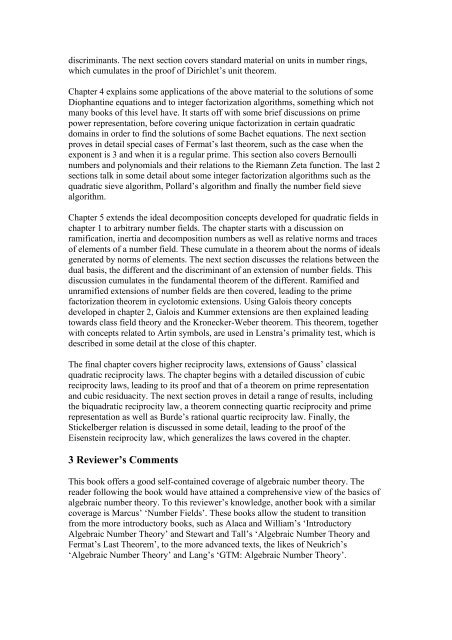(National University of Singapore).
(National University of Singapore).
(National University of Singapore).
You also want an ePaper? Increase the reach of your titles
YUMPU automatically turns print PDFs into web optimized ePapers that Google loves.
discriminants. The next section covers standard material on units in number rings,<br />
which cumulates in the pro<strong>of</strong> <strong>of</strong> Dirichlet’s unit theorem.<br />
Chapter 4 explains some applications <strong>of</strong> the above material to the solutions <strong>of</strong> some<br />
Diophantine equations and to integer factorization algorithms, something which not<br />
many books <strong>of</strong> this level have. It starts <strong>of</strong>f with some brief discussions on prime<br />
power representation, before covering unique factorization in certain quadratic<br />
domains in order to find the solutions <strong>of</strong> some Bachet equations. The next section<br />
proves in detail special cases <strong>of</strong> Fermat’s last theorem, such as the case when the<br />
exponent is 3 and when it is a regular prime. This section also covers Bernoulli<br />
numbers and polynomials and their relations to the Riemann Zeta function. The last 2<br />
sections talk in some detail about some integer factorization algorithms such as the<br />
quadratic sieve algorithm, Pollard’s algorithm and finally the number field sieve<br />
algorithm.<br />
Chapter 5 extends the ideal decomposition concepts developed for quadratic fields in<br />
chapter 1 to arbitrary number fields. The chapter starts with a discussion on<br />
ramification, inertia and decomposition numbers as well as relative norms and traces<br />
<strong>of</strong> elements <strong>of</strong> a number field. These cumulate in a theorem about the norms <strong>of</strong> ideals<br />
generated by norms <strong>of</strong> elements. The next section discusses the relations between the<br />
dual basis, the different and the discriminant <strong>of</strong> an extension <strong>of</strong> number fields. This<br />
discussion cumulates in the fundamental theorem <strong>of</strong> the different. Ramified and<br />
unramified extensions <strong>of</strong> number fields are then covered, leading to the prime<br />
factorization theorem in cyclotomic extensions. Using Galois theory concepts<br />
developed in chapter 2, Galois and Kummer extensions are then explained leading<br />
towards class field theory and the Kronecker-Weber theorem. This theorem, together<br />
with concepts related to Artin symbols, are used in Lenstra’s primality test, which is<br />
described in some detail at the close <strong>of</strong> this chapter.<br />
The final chapter covers higher reciprocity laws, extensions <strong>of</strong> Gauss’ classical<br />
quadratic reciprocity laws. The chapter begins with a detailed discussion <strong>of</strong> cubic<br />
reciprocity laws, leading to its pro<strong>of</strong> and that <strong>of</strong> a theorem on prime representation<br />
and cubic residuacity. The next section proves in detail a range <strong>of</strong> results, including<br />
the biquadratic reciprocity law, a theorem connecting quartic reciprocity and prime<br />
representation as well as Burde’s rational quartic reciprocity law. Finally, the<br />
Stickelberger relation is discussed in some detail, leading to the pro<strong>of</strong> <strong>of</strong> the<br />
Eisenstein reciprocity law, which generalizes the laws covered in the chapter.<br />
3 Reviewer’s Comments<br />
This book <strong>of</strong>fers a good self-contained coverage <strong>of</strong> algebraic number theory. The<br />
reader following the book would have attained a comprehensive view <strong>of</strong> the basics <strong>of</strong><br />
algebraic number theory. To this reviewer’s knowledge, another book with a similar<br />
coverage is Marcus’ ‘Number Fields’. These books allow the student to transition<br />
from the more introductory books, such as Alaca and William’s ‘Introductory<br />
Algebraic Number Theory’ and Stewart and Tall’s ‘Algebraic Number Theory and<br />
Fermat’s Last Theorem’, to the more advanced texts, the likes <strong>of</strong> Neukrich’s<br />
‘Algebraic Number Theory’ and Lang’s ‘GTM: Algebraic Number Theory’.
















